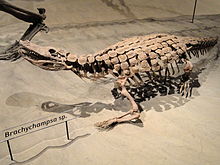
Back Brachychampsa Czech Brachychampsa Spanish کوتاهتمساح Persian ברכיצ'יימפסה HE Brachychampsa Italian Brachychampsa Dutch Brachychampsa Portuguese Brachychampsa Ukrainian
| Brachychampsa Temporal range: Late Cretaceous,
| |
|---|---|

| |
| Brachychampsa sp. | |
| Scientific classification | |
| Domain: | Eukaryota |
| Kingdom: | Animalia |
| Phylum: | Chordata |
| Class: | Reptilia |
| Clade: | Archosauromorpha |
| Clade: | Archosauriformes |
| Order: | Crocodilia |
| Clade: | Globidonta |
| Family: | Alligatoridae |
| Genus: | †Brachychampsa Gilmore, 1911[2] |
| Species | |
Brachychampsa is an extinct genus of alligatorid, possibly a basal caiman.[4] Specimens have been reported from New Mexico, Colorado, Wyoming,[5] Montana,[2][6][7] North and South Dakota,[8] New Jersey, and Saskatchewan, though only those from Montana, Utah, and New Mexico are based on material sufficient to justify the referral. Some specimens have been reported from the Campanian-aged deposits of Central Asia (Chimkent of Kazakhstan and Kirkuduk of Tajikistan), although the species status is indeterminate for these fossils.[9][10] The genus first appeared during the late Campanian stage of the Late Cretaceous (Judithian North American stage) and became extinct during the late Maastrichtian stage of the Cretaceous (Lancian North American Land Mammal "Age"). Brachychampsa is distinguished by an enlarged fifth maxillary tooth in the upper jaw.


- ^ Rio, Jonathan P.; Mannion, Philip D. (6 September 2021). "Phylogenetic analysis of a new morphological dataset elucidates the evolutionary history of Crocodylia and resolves the long-standing gharial problem". PeerJ. 9: e12094. doi:10.7717/peerj.12094. PMC 8428266. PMID 34567843.
- ^ a b c Gilmore, Charles W. (1911). "A new fossil alligator from the Hell Creek Beds of Montana" (PDF). Proceedings of the United States National Museum. 41 (1860): 297–302. doi:10.5479/si.00963801.41-1860.297.
- ^ Cite error: The named reference
Williamson 1996was invoked but never defined (see the help page). - ^ Rio, Jonathan P.; Mannion, Philip D. (2021-09-06). "Phylogenetic analysis of a new morphological dataset elucidates the evolutionary history of Crocodylia and resolves the long-standing gharial problem". PeerJ. 9: e12094. doi:10.7717/peerj.12094. ISSN 2167-8359. PMC 8428266. PMID 34567843.
- ^ Estes, R. (1964). "Fossil vertebrates from the Late Cretaceous Lance Formation, eastern Wyoming". University of California Publications in Geological Sciences. 49: 1–180.
- ^ Estes, R.; Berberian, P. (1970). "Paleoecology of a Late Cretaceous vertebrate community from Montana". Breviora. 343: 1–35.
- ^ Bryant, L. J. (1989). "Non-dinosaurian lower vertebrates across the Cretaceous-Tertiary boundary in northeastern Montana". University of California Publications in Geological Sciences. 134: 1–107.
- ^ Pearson, Dean A.; Schaefer, Terry; Johnson, Kirk R.; Nichols, Douglas J.; Hunter, John P. (2002). "Vertebrate biostratigraphy of the Hell Creek Formation in southwestern North Dakota and northwestern South Dakota". In Hartman, Joseph Herbert; Johnson, Kirk. R.; Nichols, Douglas J. (eds.). The Hell Creek Formation and the Cretaceous-Tertiary Boundary in the Northern Great Plains. An Integrated Continental Record of the End of the Cretaceous. Vol. 361. Geological Society of America. pp. 145–167. doi:10.1130/0-8137-2361-2.145. ISBN 9780813723617.
- ^ Averianov, A.; Nessov, L. (1995). "A new Cretaceous mammal from the Campanian of Kazakhstan". Neues Jahrbuch für Geologie und Paläontologie - Monatshefte. 2: 65–74. doi:10.1127/njgpm/1995/1995/65.
- ^ Martin, J.E.; Delfino, M. (2010). "Recent advances in the comprehension of the biogeography of Cretaceous European eusuchians". Palaeogeography, Palaeoclimatology, Palaeoecology. 293 (3): 406–418. Bibcode:2010PPP...293..406M. doi:10.1016/j.palaeo.2009.10.021.
© MMXXIII Rich X Search. We shall prevail. All rights reserved. Rich X Search